Nanoscale short review: Citation of MXene composites in sodium potassium electricity
QQ Academic Group: 1092348845
Detailed
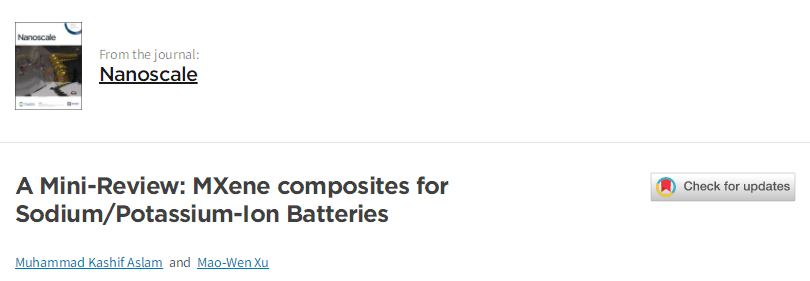

Sodium and lithium in the first group of the periodic table have similar physical and chemical properties. The content of metallic sodium in the crust is 2.83%, ranking sixth, with abundant resources and low cost. Therefore, SIB based on sodium ion reaction has received more and more attention from the academic community. The chemical properties and reserves of potassium are similar to those of sodium. The content of potassium in the crust is 2.09%, second only to sodium. K ions show lower solvent removal energy (119.2 kJ mol-1, based on propylene carbonate solvent), and can form solvents smaller than Li+ (215.8 kJ mol-1) and Na+ (158.2 kJ mol-1) Diffusion kinetics is faster. In addition, in the organic non-aqueous electrolyte, the electrode potential of K/K+ is lower than that of Na/Na+ (-SHE is -2.93 V). The low potential helps to increase the energy density of the battery. For PIB and SIB, since Al does not form an alloy with sodium or potassium, Al foil can be used as a negative electrode current collector, while LIB can only use more expensive Cu foil as a current collector, thereby further reducing battery costs. Under the trend of electric vehicles and energy storage applications, PIB with low cost, long life and high energy density has attracted more and more attention. However, the radius of K+ (1.38Å) is much larger than that of Li+ (0.76Å) and Na+ (1.02Å), which will slow down the reaction kinetics and increase the volumetric expansion of the active material during charge and discharge, which indicates The fast decay performance of electrochemistry poses new challenges to the development of electrode and electrolyte materials. Therefore, the design of high-performance anode and cathode materials is of great significance to the development of PIBs.

Recently, the research group of Professor Xu Maowen of Southwest University published a short review titled: A Mini-Review: MXene composites for Sodium/Potassium-Ion Batteries in the internationally renowned academic journal Nanoscale, which reviewed the latest research status of MXene, MXene and The synthesis method, performance and application of its composite materials in sodium ion batteries (SIBs) and potassium ion batteries (PIBs), briefly introduced the research background of SIBs, PIBs and MXene, and focused on the research of MXene composite materials in SIB and PIB Applied research, including classification by sulfide, oxide and carbon materials. Finally, the development and application prospects of MXene and its composite materials are summarized.

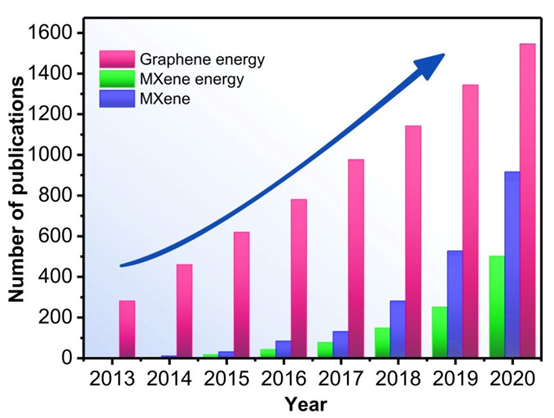
Figure 1. Publication records of MXene, MXene Energy and Graphene
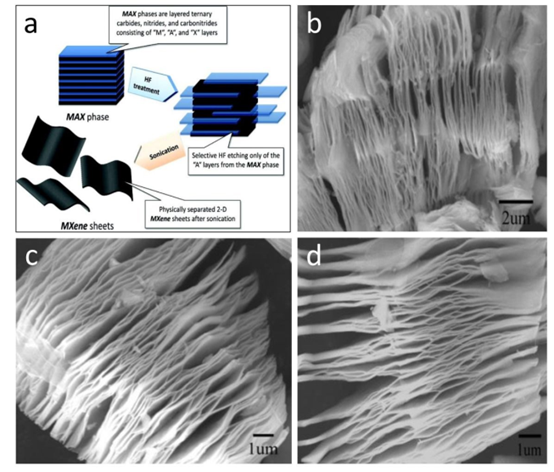
Figure 2. (a) Schematic diagram of etching and delamination of MAX phase; FESEM images of MXene (Ti2CTx) etched with fluoride salt at different temperatures (b) LiF + HCl + 50°C, (c) NaF + HCl + 60 ℃ and (d) NH4F + KF + HCl + 40℃
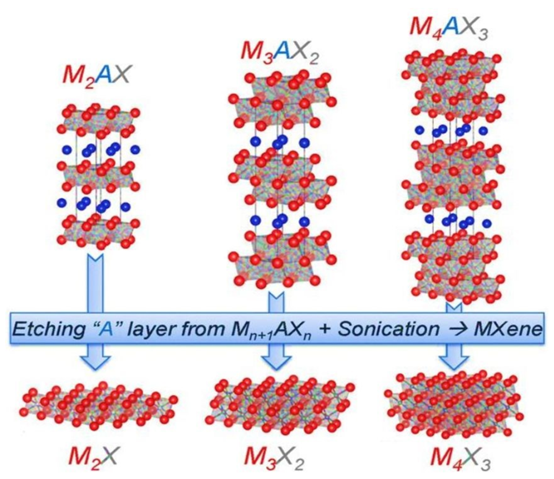
Figure 3. The structure of different types of MAX phases and corresponding MXene after etching

Figure 4. (a) MXene unit cell used to calculate the electrons and elasticity of M2C, M3C2, and M4C3 (b) F-, HO-functional and pure MXene calculation band structure (c) Semiconductor properties band structure of MXene system (D) Comparison of the synthesis scheme of polymer-CF-MXene composite and (e, f) the thermal conductivity of MXene composite
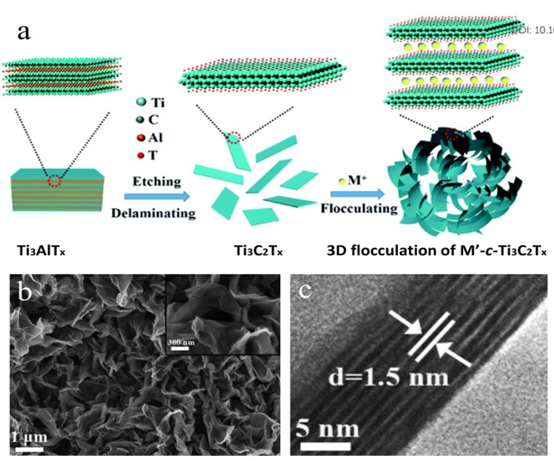
Figure 5. (a) Synthesis of M‘-c-Ti3C2TxMXene by flocculation method (Li+, Na+, K+ and TBA+), (b) FESEM image of Na+-c-Ti3C2Tx with high resolution FESEM image and (c) HRTEM Na+ -c-Ti3C2Tx image
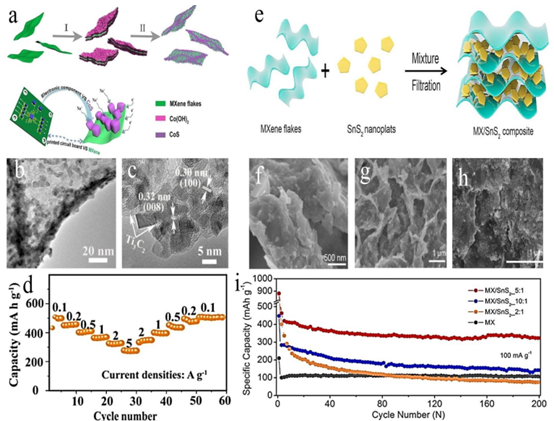
Figure 6. (a) Schematic diagram of the synthesis of CoS@MXene composite, (b, c) TEM image of CoS@MXene composite, (d) rate performance of CoS@MXene composite (e) synthesis of SnS2@MXene composite Schematic diagram, (fh) has 1:10, 1:5 and 1:2 FESEM images of SnS2@MXene composites, and (i) the magnification performance of SnS2@MXene composites
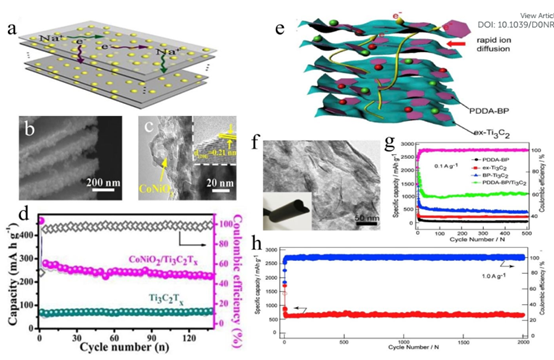
Figure 7. (a) CoNiO2@MXene charge transfer mechanism, (b) FESEM image, (c) TEM image, and (d) CoNiO2@MXene and pure MXene cycle performance (e) PDDA-BP@Ti3C2 synthesis schematic diagram , (F) FESEM image of PDDA-BP@Ti3C2, (g) cycle performance of PDDA-BP@Ti3C2 and other composite materials (h) 2000 cycle performance of PDDA-BP@Ti3C2 at 1 A g-1
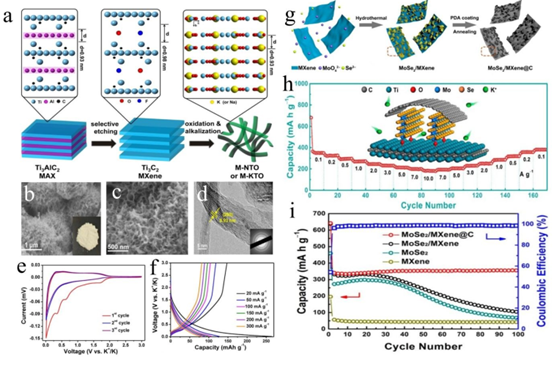
Figure 8. (a) Schematic diagram of the synthesis and atomic structure of M-KTO or M-NTO nanoribbons, (b, c) FESEM images of M-KTO nanoribbons with powdered M-KTO, (d) HRTEM Image of M-KTO with SAED illustrations, (e) the first three CV curves of M-KTO at a scan rate of 0.1 mV s-1, and (f) the charge and discharge curves of M-KTO at different current densities ( g) Schematic diagram of synthesized MoSe2@MXene/C composite material, (h) the rate performance of MoSe2@MXene/C, (i) the cycle performance of MoSe2@MXene/C and other different composite materials

This article mainly introduces the application of MXene and its composite materials in SIB and PIB. In SIB, there are many studies on MXene and sulfides, including SnS, SnS2, CoS, MoS2, etc. There are also some carbon materials and oxides. However, in PIB, they are in the early stages of research. The composite material has superior electrochemical performance than MXene itself. Among them, some methods of preparing composite materials, such as designing 3D porous MXene materials, also have good application potential in other fields. As a promising two-dimensional transition metal carbide/nitride, MXene has great research value. This article introduces the composite materials of various electrode materials and MXene, which have excellent electrochemical performance, especially in the future applications that require high volume energy density. Nevertheless, MXene still faces many challenges. In future research, we should study the structure-activity relationship among MXene surface functional groups, dopants, composite materials and material properties, and explore more advanced and friendly preparation methods. In addition, theoretical calculations and experiments are combined to explore a new two-dimensional MXene; the storage mechanism of MXene materials is the focus of future research, and the influence of chemical stability and thermal stability on energy storage performance is also the most important. We believe that with the development of research, MXene and its composite materials will show broad application prospects in energy storage (such as secondary batteries, supercapacitors), catalysis (electrocatalysis, photocatalysis) and environmental fields.
Literature link:
DOI: 10.1039/d0nr04111d
This information is from the Internet for academic exchanges. If there is any infringement, please contact us and delete it immediately
- Previous: 3D printing NiCoP/MXen
- Next: Advanced Materials | L


 mxene academic
mxene academic